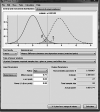Evaluation of efficacy of utility arch with inter-maxillary elastics for treating skeletal deep bite with retroclined upper incisors in the mixed dentition: a clinical randomized controlled trial
- PMID: 36735497
- PMCID: PMC10117215
- DOI: 10.2319/072722-520.1
Evaluation of efficacy of utility arch with inter-maxillary elastics for treating skeletal deep bite with retroclined upper incisors in the mixed dentition: a clinical randomized controlled trial
Abstract
Objectives: To investigate the effectiveness of utility arch (UA) with inter-maxillary elastics compared with fixed anterior bite plane (FABP) for treating deep bite in brachy-facial children.
Materials and methods: This was a single-center, randomized controlled trial. Participants were children aged between 9 and 12 years with deep bite and a hypodivergent skeletal pattern. The sample was divided into the following two groups: (1) a UA group that was composed of patients with UAs with posterior inter-maxillary elastics and (2) an FABP group as a control. Outcomes were skeletal and dentoalveolar variables on cephalometric X-rays.
Results: A total of 28 patients (13 boys, 15 girls) with a mean age of 10.66 years were enrolled. The treatment duration was 8.16 months in the UA group and 7.22 months in the FABP group. After treatment, the angle between the anterior cranial base and the mandible in the vertical plane increased significantly (P = .000) in both groups (about 1.97 degrees in the UA group and 2.75 degrees in the FABP group). Overbite decreased significantly in both groups (-2.1 m in the UA group and -3.64 m in the FABP group), but it decreased less significantly in the UA group than in the FABP group. The upper incisors flared significantly after treatment with both appliances (6.6 degrees in the UA group and 5.9 degrees in the FABP group).
Conclusions: Treatment of deep bite in children with a horizontal growth pattern by each of the appliances used in this study is effective. The mandible showed minor, significant backward rotation after treatment. The overbite decreased less in the UA group than in the FABP group.
Keywords: Children; Deep bite; Mixed dentition; Orthodontic treatment; Overbite.
© 2023 by The EH Angle Education and Research Foundation, Inc.
Figures










Similar articles
-
Evaluation of the Best Method for Orthodontic Correction of Skeletal Deep Bites in Growing Patients: A Systematic Review.Cureus. 2024 Jun 19;16(6):e62666. doi: 10.7759/cureus.62666. eCollection 2024 Jun. Cureus. 2024. PMID: 38903977 Free PMC article. Review.
-
Stable deep bite correction with true mandibular incisor intrusion in a late adolescent patient with skeletal deep bite: A case report.Int Orthod. 2019 Dec;17(4):806-816. doi: 10.1016/j.ortho.2019.08.021. Epub 2019 Aug 30. Int Orthod. 2019. PMID: 31477527
-
Severe unilateral scissors-bite with a constricted mandibular arch: Bite turbos and extra-alveolar bone screws in the infrazygomatic crests and mandibular buccal shelf.Am J Orthod Dentofacial Orthop. 2018 Oct;154(4):554-569. doi: 10.1016/j.ajodo.2017.03.032. Am J Orthod Dentofacial Orthop. 2018. PMID: 30268266
-
Evaluation of the open-bite Bionator versus the removable posterior bite plane with a tongue crib in the early treatment of skeletal anterior open bite: A randomized controlled trial.J World Fed Orthod. 2021 Dec;10(4):163-171. doi: 10.1016/j.ejwf.2021.08.001. Epub 2021 Aug 27. J World Fed Orthod. 2021. PMID: 34462242 Clinical Trial.
-
Combined orthopedic-orthodontic treatments of adolescent skeletal open-bite with severe molar-incisor hypomineralization: a case report and literature review.J Clin Pediatr Dent. 2023 Jan;47(1):91-99. doi: 10.22514/jocpd.2022.017. Epub 2023 Jan 3. J Clin Pediatr Dent. 2023. PMID: 36627225 Review.
Cited by
-
The effectiveness of anterior unilateral bite turbos in correcting incisal plane cant and asymmetric overbite: a prospective clinical study.Sci Rep. 2025 May 6;15(1):15772. doi: 10.1038/s41598-025-01035-w. Sci Rep. 2025. PMID: 40328853 Free PMC article.
-
Evaluation of the Best Method for Orthodontic Correction of Skeletal Deep Bites in Growing Patients: A Systematic Review.Cureus. 2024 Jun 19;16(6):e62666. doi: 10.7759/cureus.62666. eCollection 2024 Jun. Cureus. 2024. PMID: 38903977 Free PMC article. Review.
References
-
- Sreedhar C, Baratam S. Deep overbite—a review. Ann Essence Dent . 2009;1(1):8–25.
-
- Graber TM, Vanarsdall RL., Jr . Orthodontics Current Principles and Techniques (2nd ed) St. Louis, MO: Mosby–Year Book; 1994.
-
- Youssef M. Craniofacial growth pattern in cover-bite malocclusions and its therapeutic influencing. J Orofac Orthop . 2001;62(6):422–435. - PubMed
-
- Hultgren BW, Isaacson RJ, Erdman AG, Worms FW, Rekow ED. Growth contributions to Class II corrections based on models of mandibular morphology. Am J Orthod . 1980;78(3):310–320. - PubMed
-
- Daokar S, Agrawal G. Deep bite its etiology, diagnosis and management: a review. J Orthod Endod . 2016;2:4.
LinkOut - more resources
Full Text Sources

